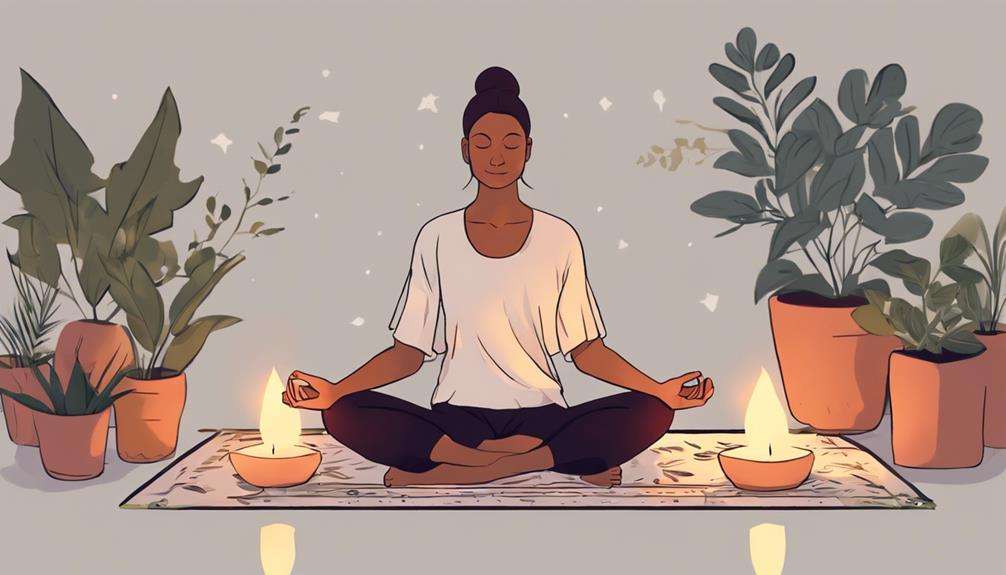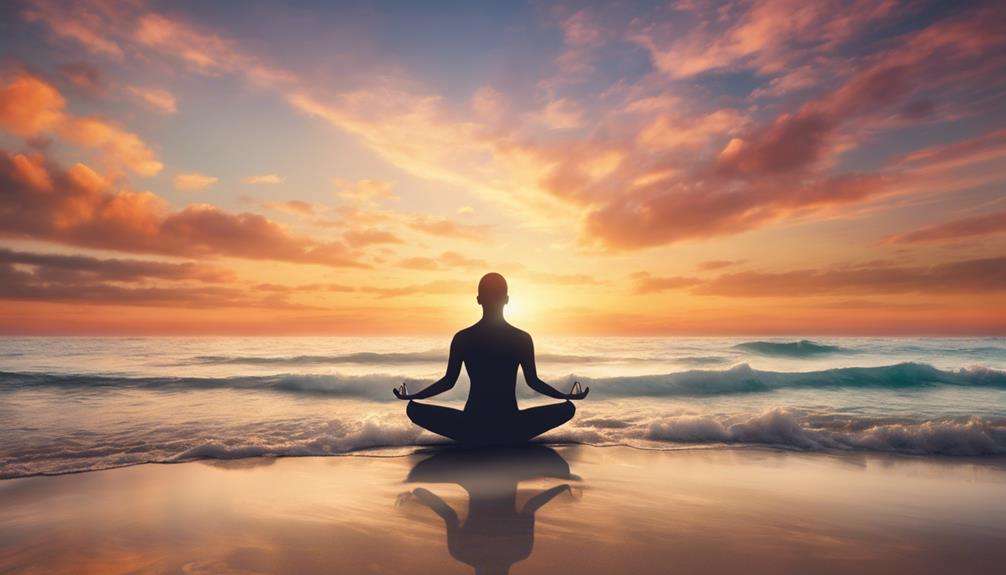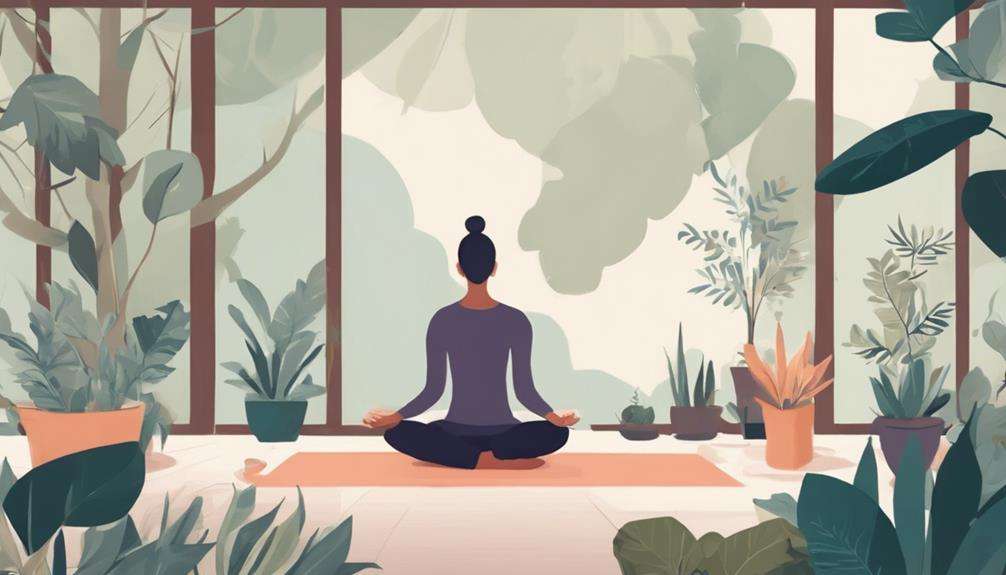You might be surprised to discover how the simple act of connecting your breath to movement can be a powerful tool in regulating your emotions. Through the practice of yoga and meditation, you can begin to explore a journey towards emotional healing and well-being.
As you navigate the realms of your inner world, you'll find a multitude of techniques and practices waiting to be explored, each offering a unique pathway towards self-discovery and growth. Embrace the potential of these ancient practices and unlock the door to a more balanced and harmonious emotional landscape.
Key Takeaways
- Yoga and meditation regulate the nervous system for emotional balance.
- Breath-focused poses aid in releasing emotional tension effectively.
- Cultivate emotional resilience through daily yoga and meditation practices.
- Enhance self-awareness and emotional intelligence for holistic healing.
The Science Behind Emotional Healing
Unlock the secrets behind emotional healing through the profound science of yoga and meditation. When it comes to healing trauma, yoga and meditation offer a powerful combination that goes beyond just physical exercise. These practices work on a deeper level, regulating the nervous system and promoting relaxation through the activation of the parasympathetic system. By incorporating meditation into your routine, you enhance self-reflection, inner peace, and emotional regulation, fostering self-awareness and self-compassion.
Yoga, with its focus on mindfulness, allows you to observe your thoughts, emotions, and sensations without becoming overwhelmed, creating a space for emotional healing to take place. The combination of yoga postures, breathwork, and meditation deepens your awareness of your body and helps you regulate your emotions effectively. Research has shown that these practices have a positive impact on the brain, reducing symptoms of various mental disorders and benefiting trauma survivors by providing a holistic approach to emotional healing.
Yoga Poses for Emotional Release
As you explore yoga poses for emotional release, remember that breath and gentle heart openers can be powerful tools for cultivating a sense of inner calm and peace.
These poses offer a safe space for you to connect with your emotions, release tension, and foster emotional balance.
Embrace these practices as ways to nurture your emotional well-being and find solace in moments of stillness and movement.
Breath and Release
Incorporate deep breathing techniques into yoga poses to facilitate the release of emotional tension and promote a sense of calm and openness within your body.
Yoga poses like Child's Pose and Cat-Cow focus on breath and movement, aiding in releasing stored emotions. Supported Bridge Pose and Legs-Up-the-Wall help calm the nervous system, fostering emotional release.
Gentle twists and side stretches in yoga poses can release emotional blockages, creating a safe space for processing and letting go of pent-up emotions. By practicing yoga poses for emotional release, you can support your journey towards healing and find a deeper connection between your mind and body.
Embrace these poses as tools for emotional healing through yoga, allowing yourself to breathe and release with each movement.
Gentle Heart Openers
Gentle heart openers in yoga offer a pathway to releasing emotional tension stored in the chest and heart area, fostering vulnerability and emotional release. Poses like supported fish pose encourage opening the chest, allowing for the release of pent-up emotions.
Embracing heart-opening yoga poses such as camel pose and bridge pose can help cultivate feelings of love, compassion, and forgiveness within yourself. By practicing these gentle heart openers regularly, you can embark on a journey of emotional healing and create space for self-compassion.
These poses aid in releasing stored emotions, bringing a sense of lightness and emotional freedom to your being. Allow yourself to embrace these poses with an open heart and witness the healing they can bring to your emotional well-being.
Meditations for Inner Peace

When seeking inner peace through meditation, remember that calmness can be found through the rhythm of your breath.
Embrace the power of mindfulness in moments of stillness, allowing your mind to settle and find clarity.
Discover the serenity that silence can offer, guiding you towards a tranquil state of being.
Calmness Through Breath
How can breath meditations assist you in finding inner peace and emotional balance?
Breath-focused meditations offer a powerful tool to help regulate your nervous system, reduce anxiety, and cultivate a sense of tranquility. Particularly beneficial for individuals dealing with trauma and mental health challenges, these practices encourage deep breathing techniques that calm the mind and promote emotional stability.
Mindfulness in Stillness
To deepen your inner peace and foster emotional balance, engaging in mindfulness in stillness meditations provides a transformative practice of cultivating presence and tranquility through focused awareness. These moments of mental stillness can be a beacon of calm in a chaotic world, offering you a sanctuary to reconnect with your inner self.
Here are three reasons why these meditations are worth exploring:
- Enhanced Mental Clarity: By observing your thoughts without judgment, you can untangle the web of your mind and gain clarity.
- Emotional Regulation: Through focused awareness, you can learn to navigate your emotions with grace and understanding.
- Improved Sense of Well-being: These yoga practices can lead to a profound sense of interconnectedness and overall well-being.
Serenity Through Silence
Embark on a journey towards inner peace and emotional balance through the transformative meditations of Serenity Through Silence. These meditations are tailored to help you navigate the complexities of mental and emotional well-being, offering a path to calm the mind, reduce anxiety, and foster emotional regulation.
By engaging in these guided practices, you can enhance self-reflection, cultivate inner peace, and restore balance in your life. The focus on quieting the mind and fostering tranquility aids in promoting self-awareness, leading to a deep sense of calm, emotional resilience, and self-compassion.
Serenity Through Silence equips you with the tools to find stillness, enhance emotional well-being, and nurture a peaceful state of mind.
Cultivating Emotional Resilience
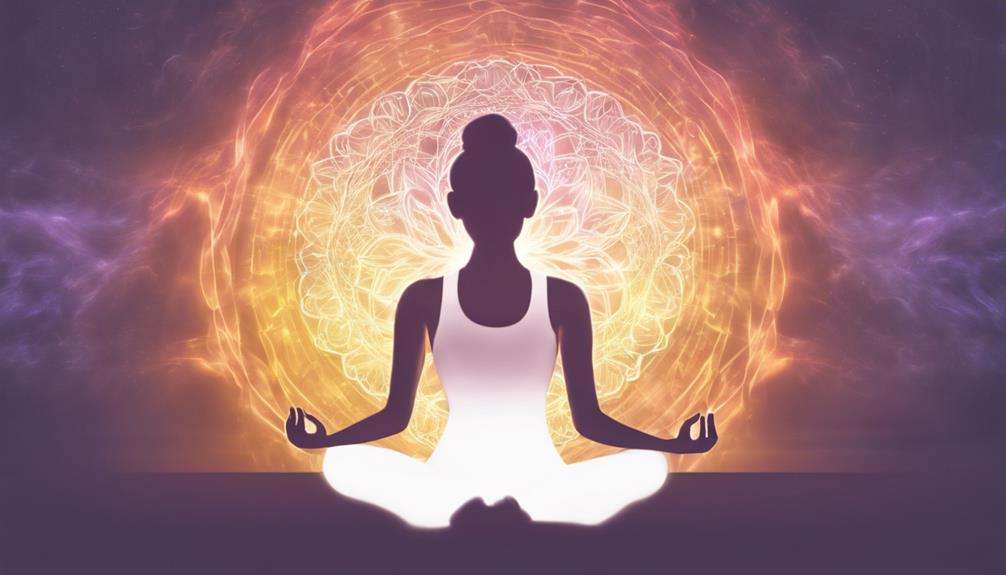
Cultivating emotional resilience through yoga and meditation involves developing the capacity to adapt and bounce back from challenges. This practice empowers you to navigate life's ups and downs with grace and strength. Here are three key ways in which yoga and meditation can help you enhance your emotional resilience:
- Mindful Awareness: Using yoga and meditation, you can cultivate a deep awareness of your mental and emotional states. By observing your thoughts and feelings without judgment, you can better understand how to respond to stressors effectively.
- Emotional Regulation: Through specific yoga postures and breathing techniques in meditation, you can soothe your nervous system and reduce feelings of anxiety. These practices provide you with tools to calm your mind and body in times of emotional turmoil.
- Daily Integration: By incorporating yoga and meditation into your daily routine, you can establish a strong foundation for emotional well-being. Consistent practice allows you to build resilience over time, enabling you to cope with difficult emotions and situations more effectively.
Mindfulness Practices for Emotional Balance
Enhancing emotional balance through mindfulness practices in yoga and meditation involves fostering self-awareness and presence in the moment. By incorporating these practices into your routine, you can cultivate a deeper understanding of your emotions and how they influence your well-being. Through yoga in healing, you can learn to observe your feelings without immediate reaction, allowing for a more thoughtful response to challenging situations. This approach to emotion regulation can lead to a greater sense of inner peace and calm in your daily life.
Mindfulness practices encourage you to acknowledge your emotions without judgment, creating space for acceptance and growth. By regularly engaging in these techniques, you can develop a more resilient mindset that's better equipped to handle stress and adversity. Embracing mindfulness in yoga and meditation offers a pathway to improving your emotional regulation, reducing the impact of negative emotions, and fostering a positive outlook on life. Take the time to explore these practices and discover the transformative effects they can have on your emotional well-being.
Integrating Yoga and Meditation for Healing
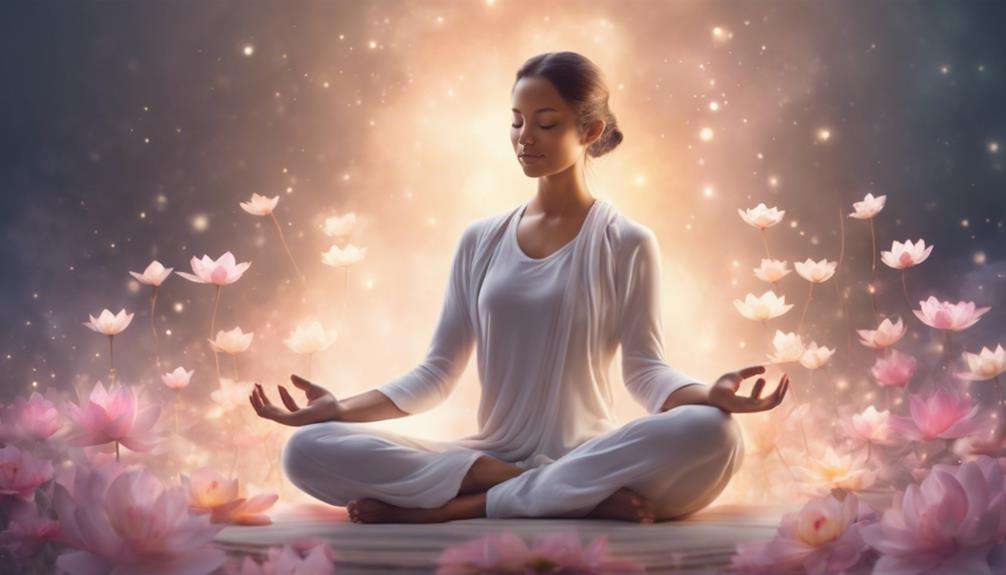
To deepen your healing journey, consider integrating yoga and meditation as powerful tools for fostering emotional well-being and self-awareness. Here are three key ways in which combining yoga and meditation can support your healing process:
- Guidance from a Yoga Teacher: Engaging with a knowledgeable yoga teacher can provide you with personalized instruction, alignment cues, and support as you navigate your practice. A skilled teacher can help tailor yoga poses and meditation techniques to address emotional wounds and physical pain effectively.
- Physical Pain Management: Yoga's focus on physical postures and breathwork can help alleviate physical pain by releasing tension, improving flexibility, and promoting relaxation. By incorporating meditation alongside yoga, you can enhance your ability to manage and reduce physical discomfort, allowing for a more holistic approach to healing.
- Emotional Resilience Building: The combination of yoga and meditation cultivates emotional resilience by encouraging self-reflection, mindfulness, and self-compassion. This integration enables you to develop a deeper understanding of your emotions, navigate challenging feelings with greater ease, and foster inner peace amidst emotional turmoil.
Frequently Asked Questions
Can Yoga Help Emotional Healing?
Yes, yoga can significantly aid emotional healing. Its benefits extend beyond physical fitness, helping to cultivate emotional balance and resilience. By integrating yoga into your routine, you can foster a sense of inner calm and well-being.
Does Yoga Release Trapped Emotions?
Yoga can indeed help release trapped emotions, allowing emotional release and promoting energy balance within you. By engaging in yoga postures and meditation, you can access and process suppressed emotions, leading to healing.
How Do You Meditate for Emotional Healing?
To meditate for emotional healing, focus on breathwork techniques and mindfulness practices. Allow yourself to sit with your emotions, observing without judgment. Breathe deeply, connecting with your inner self to find peace and healing.
Why Do I Cry After Yoga?
When you cry after yoga, it's a sign of emotional release through the mind-body connection. Tears flow to cleanse and heal stored emotions. Let them out; it's a natural and healthy way to find emotional balance.
Conclusion
As you journey through the powerful practices of yoga and meditation, remember that healing emotions is like tending to a garden – it takes time, patience, and gentle care.
By cultivating emotional resilience, practicing mindfulness, and integrating these tools into your daily life, you're nurturing the seeds of inner peace and personal growth.
Embrace the transformative power of these ancient practices, and watch as your emotional well-being blossoms like a beautiful flower in bloom.


